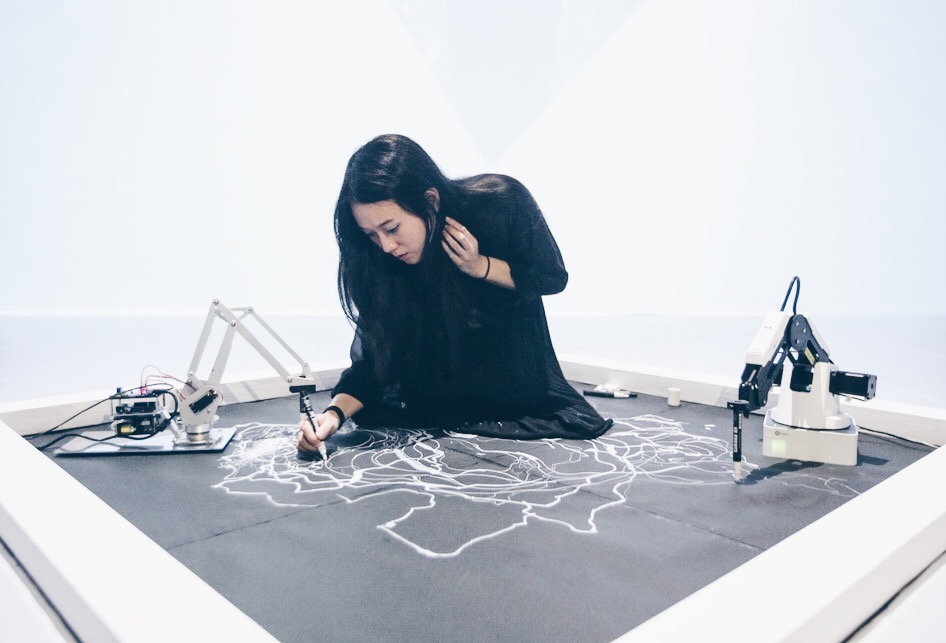By Sougwen Chung
In response to The Architect is Dead
Published by Architectural Association in London
The proliferation of computation is bringing about a paradigm shift. From marks made by hand toward marks made by machine, we invite the question: if machines are able to execute actions traditionally performed by humans, will the human hand be replaced?
Contemporary artists with a forward-thinking approach are responding to this question by imagining new pluralities, rejecting the simplistic binary of human or machine. Through explorations of machine automation as an artistic medium, artists are defining paradigms of human and machine as intertwined agencies informing each other. Through co-authorship of organic and computational intelligence, an expanded notion of collaboration sets the stage for vital new inter-subjectivities[1]. Thus, we investigate how might the conception of human agency need to evolve.
Allegories of Human & Machine in Art
Art, by necessity, provokes speculation. Artistic movements have long helped shape a cultural understanding of historical epochs through allegorical lineage, linking the role of the artist to conceptions of agency — from Michelangelo’s hand setting an angel free from marble,[2] to omniscient arm of SEEK that shape the environment of its citizens,[3] to the works of today, exploring the emergent possibilities of human and machine.
During the renaissance, the artist’s hand was considered God’s vessel by religious institutions. Michelangelo's Angel of Arca di San Domenico[4] was a valorized motif, an idealized form waiting to emerge from its captivity in stone – he artist’s skill was secondary. Michaelangelo’s role as an artist was that of a facilitator of religious wonder – an intermediary between the commonality of man and the sublime.
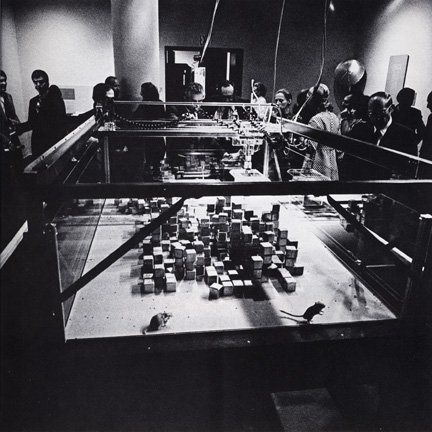
In the case of SEEK,[5] the machine’s hand was omniscient. The machine’s prescient use of computer vision technology introduced a synthetic mode of sensing that contrasted the organic sensory apparatus of its gerbil subjects. The project simulated computational sovereignty via a robotic entity that was responsible for maintaining order in an environment based on a predetermined set of rules that determined environmental changes informed by its population’s response to previous iterations. SEEK was an early example of automation and computational governance provided by a simulation of a self-organizing and self-referential system. SEEK provided a metaphor for how technological systems could potentially govern behavior.
Allegories in art reflect and shape the social values of their historical context. Michelangelo's works in the renaissance can be seen as glorifying religious iconography with the scope of supporting the church’s governing dogma. SEEK and comparable works in media art effectively simulated the regulating influence of systems, a prescient concept in 1969 and a precursor to the networked systems of today. On one side of the spectrum, the fictive machines as a consummate offspring of humankind (combining the tendency towards pareidolia with imaginative delusions of grandeur). On the other, machines that render humankind obsolete affirm a fatalistic mindset. While such ideas might satisfy the tendency towards utopian and dystopian fantasies about technology, they emphasize a reductive binary of human or machine.
Man or Machine
Throughout time, we have witnessed the ways in which cultural shifts provoke anxiety and how, beneath the tectonic plates of the establishment, they dismantle structures. With that in mind, it can be tempting to mythologize the utopian belief in a hypothetical emergent intelligence within the computational operations of the machine as a seraph enclosed within the substrate of bits and bytes. To seek sublime within sublimation. These myths provide comfort and a stabilizing, yet perhaps naive, optimism. But if we operate under this assumption, what becomes of human agency, as embodied by the artist’s hand? Is it no longer required?
The reality of today’s technological landscape is more complex. What is a representative microcosm of the overall megastructure? As alluded to in prescient works like SEEK, the effect of computational governance is at once non-neutral,[6] ubiquitous and invisible. Systems link to form an interconnected network that sees and yet is unseen. The anatomy of the network, its sensors, its data collection and influence, are rarely in the frames of mind of the users it governs. It is these conditions that have contributed to the intractable effect of technology in the ebb and flow of modern life. It is “an accidental megastructure, one that we are building both deliberately and unwittingly and is in turn building us in its own image.”[7]
Man and Machine
Today, artists are caught in a cacophonous feedback loop as they ricochet between the tradition of art (manifesting social consciousness and reflecting on human experience) and the increased presence of machine automation (proliferated in tools, software, sensors, and robots). The modern psyche is on a transitional edge. We are charged with constructing intellectual and philosophical frameworks alongside the technologies that are simultaneously shifting perceptions of human agency.
AARON: Extension
Take AARON, a computer program designed in 1973 by artist Harold Cohen, as an example. Trained as a painter long before AARON began, Cohen’s project translated singular artistic intention through computers. In this project, the machine operated as an extension of the artist’s vision. Cohen defined the system according to his own aesthetic sensibility. The machine’s rule-based system used familiar motifs within the genre of painting such as people and plants, which eventually shifted towards abstraction in later years.[8] In this project, Cohen programed the machine to paint a series of novel images and acted as the overseer of the work – absolving him from contributing physically to the painting and privileging didactic over dialogical methodology. Cohen prefered to extend his agency through a machine by translating his artistic vision into computational language. AARON executed permeations on a style, but did not invent its own original style beyond Cohen’s predefined set of rules. Thus, the limitations of the output were predetermined. The artist, for Cohen, was a designer of systems and an interrogator of authorship.
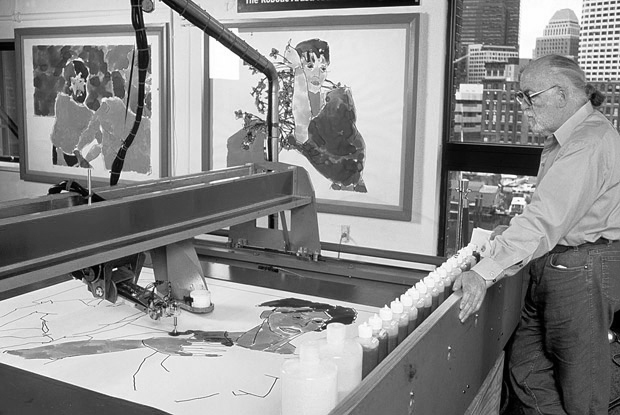
The creativity described in Cohen’s work is linear, as it begins with the artist and ends with the machine. The human and machine gestures remain separate because the mechanical operations are executional. Cohen creates the rules for AARON to follow and they never occupy the same space in time. With this approach, Cohen occupies a privileged space in the interaction with the machine because his vision is absolute, perfect, unchallenged, non culpable. While the authorship may be in question, the roles occupied by human and machine are not. Now, Cohen is able to produce posthumously through automated agency. In questioning authorship, we challenge the definition of creativity. But what of collective authorship?
Drawing Operations: Towards Collaboration
Since 1969, it could be said that we are all living in a Blockworld described by SEEK, overseen by an accidental megastructure fed by memes, gps data, satellite imaging, reddit threads, remix culture, and unfortunate flash mobs. The “landscape” of human extension through networked devices has contributed to the widespread digitization and regurgitation of culture.
Ambiguous authorship has introduced incredible complexity into the network. Inspired by Cohen’s AARON, artists have continued to create visual systems that can produce infinite permutations upon a theme. The linearity of Cohen’s human and machine has extended to form a loop. Now, the conversation has grown to explore what happens to agency, originality, and authorship after we extend ourselves through machines, spawning a new generation of artistic inquiry. Notably, the Hong Kong international exhibition Ubiquitous Humanity explored the boundary between human and the mechanical through collaborative and interactive pieces, such as D.O.U.G.[9]
Drawing Operations Unit: Generation 1 (D.O.U.G.)
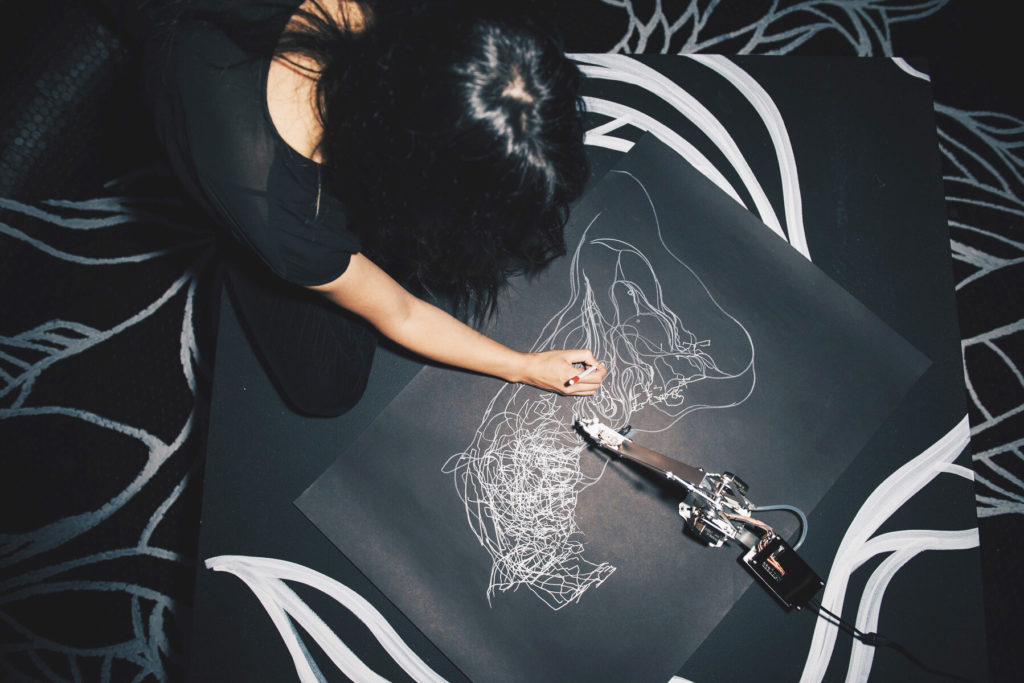
I introduced Drawing Operations Unit: Generation 1 (D.O.U.G.) as a performance piece investigating automation, autonomy, and collaboration in 2015. In Generation 1, the robot (D.O.U.G_1) and I draw together. The machine mimics my gestures in real time via computer vision, which results in a synchronous collaboration between human and machine. Set as a 20 minute performance, the demonstration of co-creation builds upon the mechanical extension proposed by Harold Cohen’s AARON and suggests a metaphor for human machine symbiosis through behavioral empathy.
In Generation 1: Mimicry, both human and robotic agent are creatively implicated through the act of performance. As D.O.U.G._1 mimics my movements, we create a visual language and cohesion manifested through a sustained awareness of mechanical and human marks. The project is primarily concerned with ambiguity and interoperability in a machine and computer mediated creative process. We create a feedback loop within the performance that allows for a fluid dialog between the mark made by a human hand and a mark made by machine.
Through this work, I suggest that separation between collaborators is inconsequential. The producer and the impersonator are indistinguishable, and there is no leader or follower as they endlessly follow each other. Ultimately, the authorship of the resulting artwork is un-ascribable. The folie-a-deux’s[10] binding creation may only be attributed by compulsory collaboration, a shared (polycentric) improvisation. In Generation 1, my improvised gesture is an extension of experience, emotion, subjective, moment, impulse control, dexterity, and rhythm translation over time. The robot’s movements are circuitry and servos, with its vision in pixels and coordinates, and electricity driving its movement, but also sight, interpretation, “understanding”, “parsing”, “learning”, and “data sets”.[11]
In an evolutionary progression, Generation 2 of Drawing Operations matures the interaction model of artist and machine from mimicry to memory via machine learning.[12] Gestural data extracted from my archives are fed into training models, simulating a neural network. The training models interpret archives of images, which provide a foundation of a rudimentary understanding of style. Effectively, the robotic arm begins to learn from the style of the artist’s hand throughout time. The system learns the stylistic patterns of its human counterpart, and, in a sense, interprets the history of the artist’s archives, learning to “independently” produce its own conclusions. The performance can be thought of as a collaborative simulation between an artist and her own mechanical doppelgänger. By doing so, Drawing Operations embraces indeterminacy in the age of mechanical production by implicating the machine as artistic collaborator, or possibly, originator. Not only does this place the authorship of the artwork in question, but it also speculates on the necessary evolution of our existing conception of collaboration.
Generation 2 teases at future applications of machine learning intertwined with artistic production – not limited to a single artist, but inclusive of a wider breadth of artistic sources. The machine as collaborator may invent a range of styles beyond the imagination of the human artist, as digitized archives of drawing take on a new life. By cataloguing art history as training data, the machine may be able to forecast, produce and thus originate future movements and styles by tracing and speculating the provocation of artistic development over time.
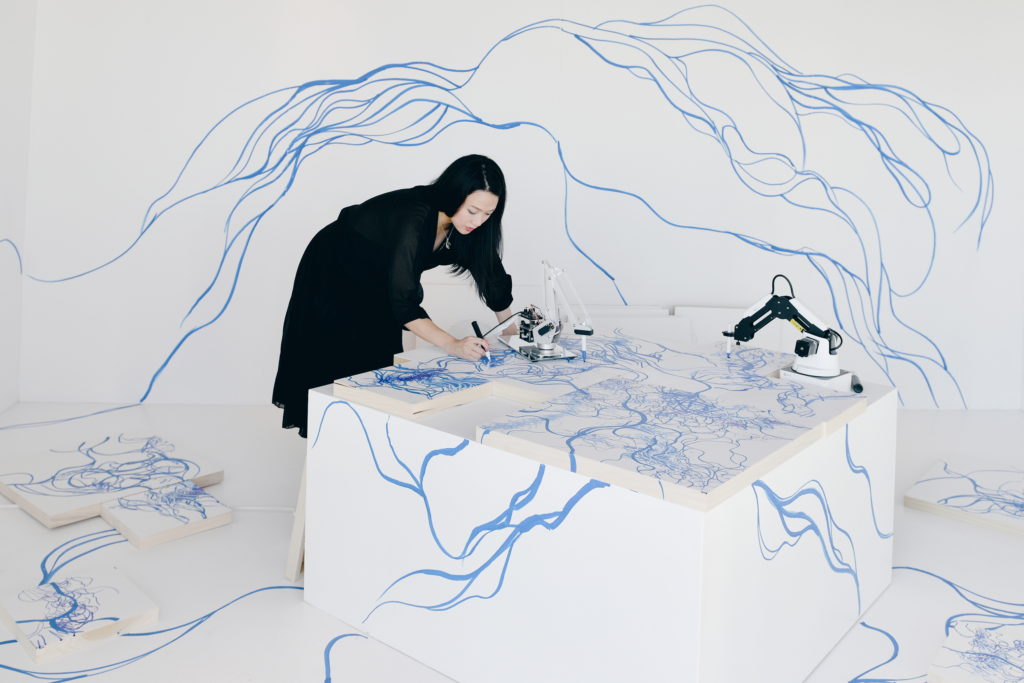
Overall, the pursuit of multi-threaded agency is poised to stimulate new ways of seeing, sensing and decoding the artistic process. In this framework, the process of creation is as much a part of the artwork as the visual outcome, if not more so. In a sense, the artistic agency questioned within the Drawing Operations project is a composited interoperation. It embraces creative ambiguity in the work, rendering full credit beyond the grasp of human or machine, suggesting the obsolescence of the distinction. In exploring a continuously blurring of distinction between self and machine, Drawing Operations fuels speculation upon inclusive models of radical inter-subjectivities.[13]
What’s to come
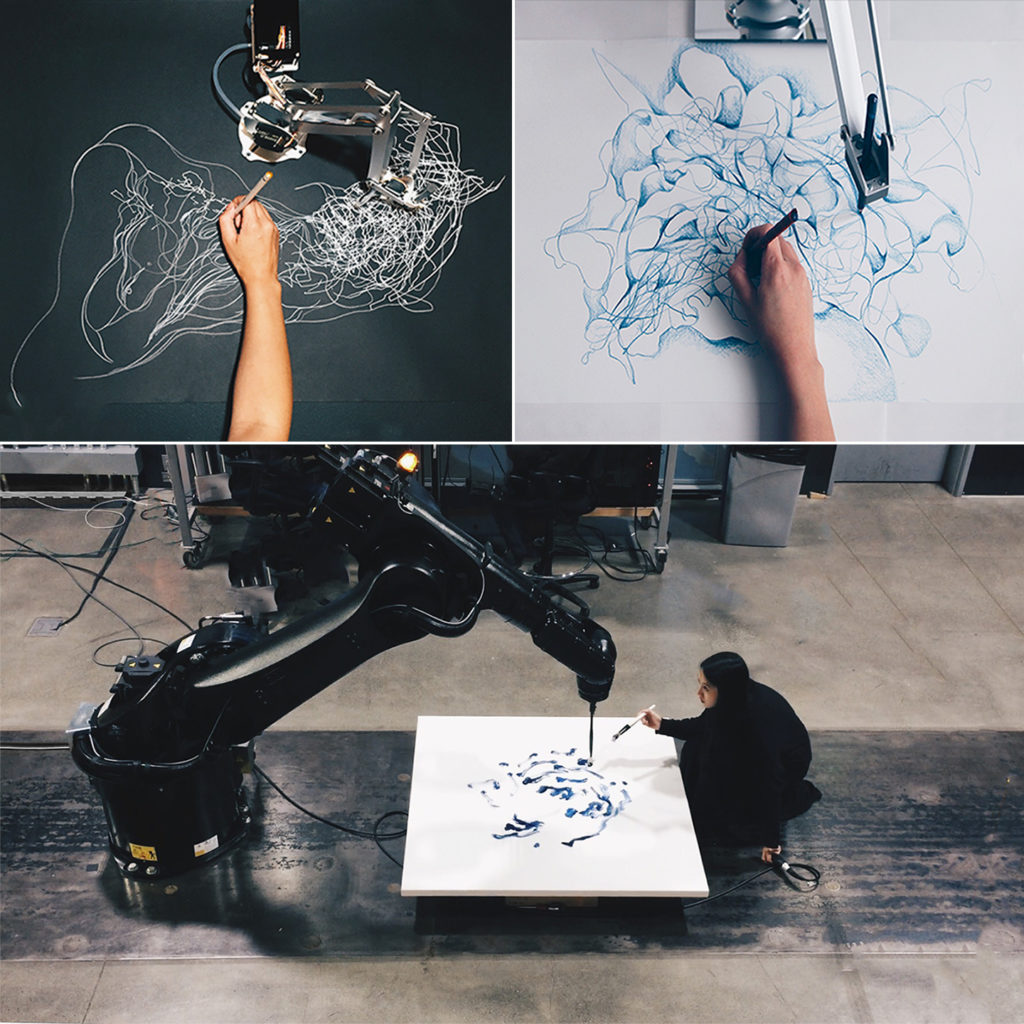
Beyond the adversarial binary of human versus machine lies a spectrum of intertwined conceptions of biological and mechanical agencies. In this pursuit, emerging themes will be shaped by emergent interconnectivity. Developments in brain computer interfaces are heralding a generation of responsive prosthetics as cognitive extensions of the mind.[14][15] In competitive gaming through online communities, human players are competing with learning systems inspired by their own playing styles. By doing so, players are evolving new strategies for competing with machines,[16] as well as extending notions of beauty within gameplay.[17] In tandem, by capitalizing on recent advances in audio codecs and digital signal processing, researchers are exploring ways that haptic feedback can be used to restore perceptions, and perhaps create new ones.[18] Multi-player virtual reality may eventually lead to the normalization of post-geographic communal spaces and extend the idea of co-presence within an abstracted space.[19] Works that are manifold and cooperative, inspired by shared sensorial and spatial experiences, will espouse the imagining of complex new inter-subjectivities.
By examining the co-authorship of human and machine in the context of building, artworks offer allegories for how we can potentially navigate technological change, providing models for how the multi-sensorial data collected from humans, machines and the environment applies to the human experience. Beyond adversarial binaries, towards a promiscuously inclusive, multi-species array of cognizing agents — mechanical and biological, singular and composite, discovered and soon-to-be discovered. We are moving from a mark made by hand and a mark made by machine toward a mark made of something else entirely.
[1] Harari, Yuval N. Sapiens: A Brief History of Humankind. Toronto, Ontario: Signal, McClelland & Stewart, 2016. Print.
[2] “Io intendo scultura quella che si fa per forza di levare: quella che si fa per via di porre è simile alla pittura.” a basis for the interpretive translation "I saw the angel in the marble and carved until I set it free." "Lettera a Messer Benedetto Varchi." Lettera a Messer Benedetto Varchi - Wikisource. N.p., n.d. Web. 20 June 2017.
[3] Vardouli, Theodora. "Nicholas Negroponte: An Interview." Open|architectures. N.p., 26 Oct. 2011. Web. 20 June 2017.
[4] "Angel (Michelangelo)." Wikipedia. Wikimedia Foundation, 11 June 2017. Web. 20 June 2017.
[5] Vardouli, Theodora. "Nicholas Negroponte: An Interview." Open|architectures. N.p., 26 Oct. 2011. Web. 20 June 2017.
[6] Kranzberg, Melvin. "Technology and History: "Kranzberg's Laws"." Technology and Culture27.3 (1986): 544. Web.
[7] Bratton, Benjamin H. The Stack - On Software and Sovereignty. Massachusetts: MIT, 2016. Print.
[8] "The Further Exploits of AARON, Painter." The Further Exploits of AARON, Painter. Stanford, 22 July 1995. Web. 23 June 2017. SEHR, volume 4, issue 2: Constructions of the Mind
[9] The 2016 Hong Kong group exhibition Ubiquitous Humanity comprised of a selection of works curated by Takahashi Mizuki addressing the role of technology in expanding human sensitivity (physical, emotional and behavioral), examining the boundaries between the human and mechanical through visual, collaborative, and interactive experiments.
[10] Metaphorically, “shared psychosis”, is a psychiatric syndrome whereby its symptoms are shared by more than two people by transmission. Berrios, G. E. & Marková, I. S.. “Shared Pathologies”. In Bhugra D & Malhi G (eds) Troublesome disguises. Managing challenging Disorders in Psychiatry. 2nd Edition, London, Wiley, 2015. pp.3-15.
[11] DOUG’s mechanical mode of production becomes the same tool as the artist’s tool for expression.
[12] The readability of massive quantities of data is the focus of the field of machine learning, which has been thriving on the mass data sets generated by humans, and the advancement of processing speeds. Machine learning algorithms are being trained on this data, and the techniques are improving in sophistication. The machine learning of today utilizes neural networks to glean behavioral patterns from the collected data of humans through images and text, which, en masse, form encoded impressions of the collective as a whole.
[13] DOUG heeds an imagining of machine and human that transitions beyond the conventional species-specific binary of human vs machine, by presenting a ulterior model of interaction derived of multiple artists.
[14] Xu, Zhe, and Emanuel Todorov. "Design of a Highly Biomimetic Anthropomorphic Robotic Hand towards Artificial Limb Regeneration." 2016 IEEE International Conference on Robotics and Automation (ICRA) (2016): n. pag. Web.
[15] Clark, Andy, and David J. Chalmers. "The Extended Mind." The Extended Mind (2010): 26-42. Web.
[16] Metz, Cade. "The Rise of Artificial Intelligence and the End of Code." Wired. Conde Nast, 01 May 2017. Web. 20 June 2017.
[17] Metz, Cade. "The Sadness and Beauty of Watching Google's AI Play Go." Wired. Conde Nast, 03 June 2017. Web. 20 June 2017.
[18] Novich, S.D. & Eagleman, D.M. Exp Brain Res (2015) 233: 2777. doi:10.1007/s00221-015-4346-1
[19] Sudoscript. "When Pixels Collide." Sudoscript. Sudoscript, 16 Apr. 2017. Web. 20 June 2017.
